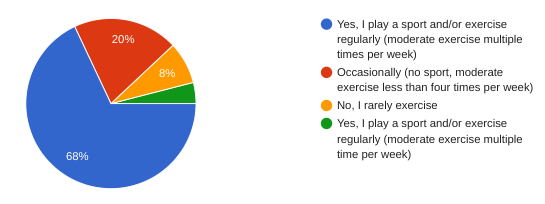
By Sasha Semanision
You’re probably sitting down as you read this. How long have you been sitting there? If it’s been a while, maybe take a quick break to stand up and go for a walk.
Sometimes it’s easy to sit and focus on a task for hours, forgetting to schedule time to exercise, or not wanting to because you feel lethargic from sitting there for so long. I myself am often guilty of this. And sometimes I just don’t feel like exercising. For some people, these factors result in doing very little physical activity. Some would prefer to continue to live this sedentary lifestyle, but there’s so much benefit from physical activity that people really need to give it a chance. And being inactive has many negative consequences.
To start, there are the obvious physical problems that come with inactivity. According to the CDC, inactivity can increase the risk of many serious physical issues.
“Not getting enough physical activity can lead to heart disease—even for people who have no other risk factors. It can also increase the likelihood of developing other heart disease risk factors, including obesity, high blood pressure, high blood cholesterol, and type 2 diabetes… Getting the recommended amount of physical activity can lower the risk of many cancers, including cancers of the breast, colon, and uterus.”
More Americans are sedentary than in previous years; people are not in good physical condition which raises concerns. According to the CDC, in 2020, only about one quarter of U.S. adults met both the aerobic and strength guidelines.
I also chose to address the benefits of physical activity since it’s almost summer. Because of the warm weather, and longer days, people have more incentive and opportunity to exercise outside and make it a positive experience.
In addition to negating the problems that come with inactivity, an active lifestyle also has many benefits. According to the CDC, exercise can help prevent cancer, reduce the risk of developing dementia, and improve bone strength, coordination and heart health.
It also has physiological benefits, including improving sleep quality and energy. I can confirm that it does improve both my energy and sleep, because when I don’t exercise for a few weeks, I notice a significant decrease in my energy, even if I get enough sleep.
Exercising enough can also increase productivity because of having more energy and a better mood. According to the Mayo Clinic, aerobic exercise can release endorphins. Other sources also mention that weight training releases endorphins. From my experience, I can confirm that both do. For the physiological benefits alone, it’s worth it to give exercise a try if you don’t.
Many people don’t want to exercise because they don’t think they have enough time to. And sometimes it’s really hard for people to make the time to workout. Many people have inactive jobs that don’t allow them to get in any exercise at work. According to Johns Hopkins medicine, sedentary jobs have increased 83 percent since 1950. People have long commutes and work hours. They have busy lives, having to take care of their children or other dependent family members. These, and other situations, could restrict people’s activity levels, but some people still exercise because they don’t prioritize it.
Since the CDC recommends a minimum of only 150 minutes of moderate activity per week, think of how little time you’d really save by not exercising. People often don’t actually lack the time to exercise, but the motivation to. Some people don’t want to work out because they don’t have the energy to. This is understandable. It’s exhausting at first, but exercising will get easier and eventually improve your energy throughout the day. The final reason why most people don’t like to exercise is because it’s unpleasant. This is… sometimes true. Intense exercise can be very unpleasant. But people who think that exercising is unpleasant might be doing the wrong kind of exercise.
For most people, there is no need to go run or lift weights at a high intensity for hours or anything of that sort. Exercise can be more fun. Cardio obviously doesn’t have to be running; it can be cycling, swimming, dancing etc. Resistance training doesn’t have to be a brutal workout every day; it can be as easy as doing some calisthenics (bodyweight exercises) or if you have access to a gym, lifting 2-4 times per week. Some people have the impression that working out is supposed to be this grueling thing you do for hours every day, but it really doesn’t need to be.
The final issue that I’ve had with exercising regularly that other people might have is losing motivation or getting burnt out and quitting. If you train only when you feel like it, randomly, it’s easy to forget, procrastinate or quit. About 75 percent of the time when I say “I’ll do it later” I either do less than my original goal or don’t do anything. To avoid this, really try to stick to a schedule when possible. And to avoid getting burnt out, try different types of workouts occasionally, maybe even something you don’t like as much, just for a change.
Overall, it might seem like a waste of time to exercise at first, or a waste of effort, but after being reminded of the benefits, I hope that this convinced you otherwise. If you don’t regularly exercise, you should give a more active lifestyle a try.